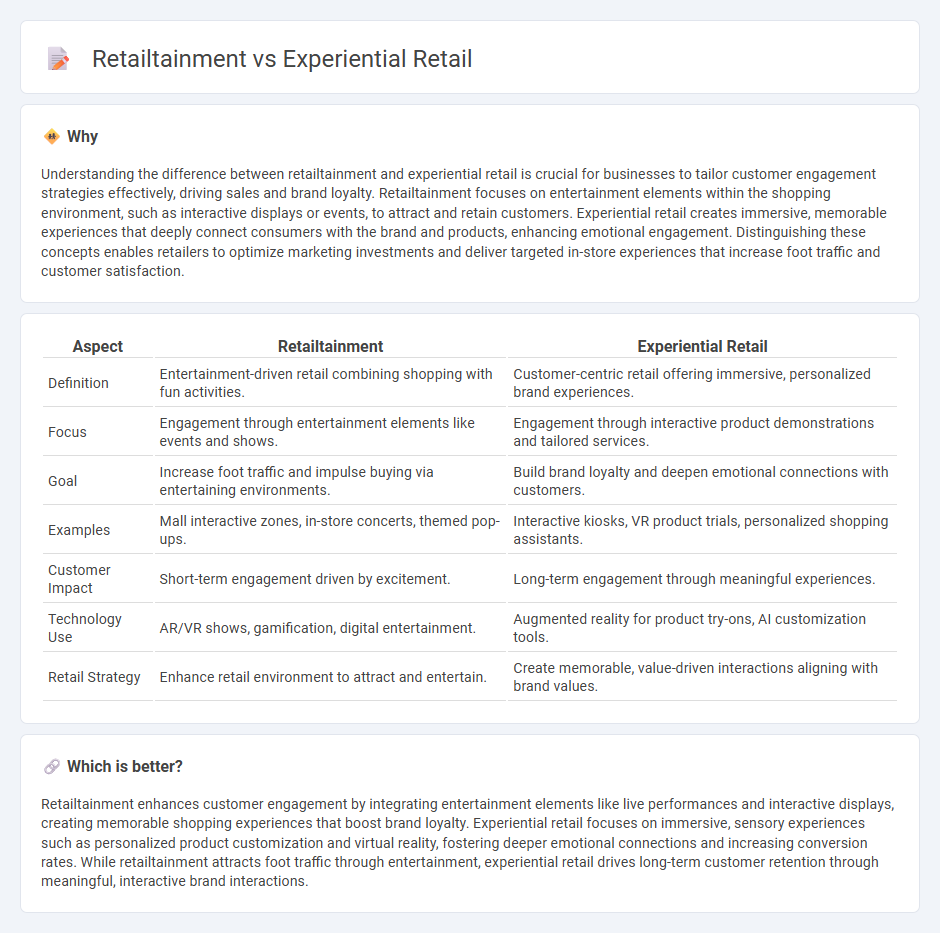
Retailtainment combines entertainment elements with shopping to create engaging consumer experiences that increase dwell time and boost sales. Experiential retail focuses on immersive, personalized interactions that connect customers emotionally to brands, driving loyalty and repeat visits. Explore more about how these innovative retail strategies transform customer engagement and business performance.
Why it is important
Understanding the difference between retailtainment and experiential retail is crucial for businesses to tailor customer engagement strategies effectively, driving sales and brand loyalty. Retailtainment focuses on entertainment elements within the shopping environment, such as interactive displays or events, to attract and retain customers. Experiential retail creates immersive, memorable experiences that deeply connect consumers with the brand and products, enhancing emotional engagement. Distinguishing these concepts enables retailers to optimize marketing investments and deliver targeted in-store experiences that increase foot traffic and customer satisfaction.
Comparison Table
| Aspect | Retailtainment | Experiential Retail |
|---|---|---|
| Definition | Entertainment-driven retail combining shopping with fun activities. | Customer-centric retail offering immersive, personalized brand experiences. |
| Focus | Engagement through entertainment elements like events and shows. | Engagement through interactive product demonstrations and tailored services. |
| Goal | Increase foot traffic and impulse buying via entertaining environments. | Build brand loyalty and deepen emotional connections with customers. |
| Examples | Mall interactive zones, in-store concerts, themed pop-ups. | Interactive kiosks, VR product trials, personalized shopping assistants. |
| Customer Impact | Short-term engagement driven by excitement. | Long-term engagement through meaningful experiences. |
| Technology Use | AR/VR shows, gamification, digital entertainment. | Augmented reality for product try-ons, AI customization tools. |
| Retail Strategy | Enhance retail environment to attract and entertain. | Create memorable, value-driven interactions aligning with brand values. |
Which is better?
Retailtainment enhances customer engagement by integrating entertainment elements like live performances and interactive displays, creating memorable shopping experiences that boost brand loyalty. Experiential retail focuses on immersive, sensory experiences such as personalized product customization and virtual reality, fostering deeper emotional connections and increasing conversion rates. While retailtainment attracts foot traffic through entertainment, experiential retail drives long-term customer retention through meaningful, interactive brand interactions.
Connection
Retailtainment and experiential retail both focus on enhancing customer engagement by blending entertainment and interactive experiences within the shopping environment. Retailtainment uses live performances, games, and multimedia to attract and retain customers, while experiential retail emphasizes immersive product interactions and personalized services. Together, these concepts redefine traditional retail by creating memorable, multisensory shopping journeys that increase brand loyalty and drive sales.
Key Terms
Immersive Experience
Experiential retail centers on creating personalized, sensory-rich shopping environments that engage customers through interactive product displays and tactile experiences. Retailtainment combines entertainment elements such as live performances, games, and themed events within retail spaces to captivate audiences and extend visit durations. Explore how immersive experiences transform traditional shopping into dynamic consumer journeys by diving deeper into this evolving trend.
Interactive Engagement
Experiential retail emphasizes immersive, sensory-rich shopping environments designed to create meaningful customer interactions and emotional connections with brands. Retailtainment blends retail and entertainment by incorporating live performances, games, and interactive technology to captivate visitors and extend their stay. Explore more about how these strategies transform consumer experiences and drive brand loyalty.
Sensory Stimulation
Experiential retail emphasizes immersive shopping environments that engage multiple senses to create memorable customer experiences, enhancing brand loyalty and increasing dwell time. Retailtainment combines entertainment elements with retail spaces, often incorporating interactive sensory stimulation such as sound, lighting, and tactile displays to captivate and retain shoppers. Explore how leading brands utilize sensory stimulation strategies to transform retail environments and drive consumer engagement.
Source and External Links
Experiential retail - Wikipedia - Experiential retail is a retail marketing strategy that offers customers experiences beyond traditional shopping, such as interactive art, music, VR, and social spaces, aiming especially at Millennials who value experiences over material goods.
What is Experiential Retail? An Inside Look - Lightspeed - Experiential retail focuses on customer engagement through immersive and brand-centric experiences rather than direct sales, exemplified by brands like Glossier creating interactive, magical store environments that foster strong customer loyalty.
6 Best Experiential Retail Examples for 2024 - Bridgewater Studio - Experiential retail involves creating multisensory, immersive in-store experiences such as interactive demos, digital tech integrations, and community-focused events to deepen emotional customer connections and move beyond just transactions.
 dowidth.com
dowidth.com